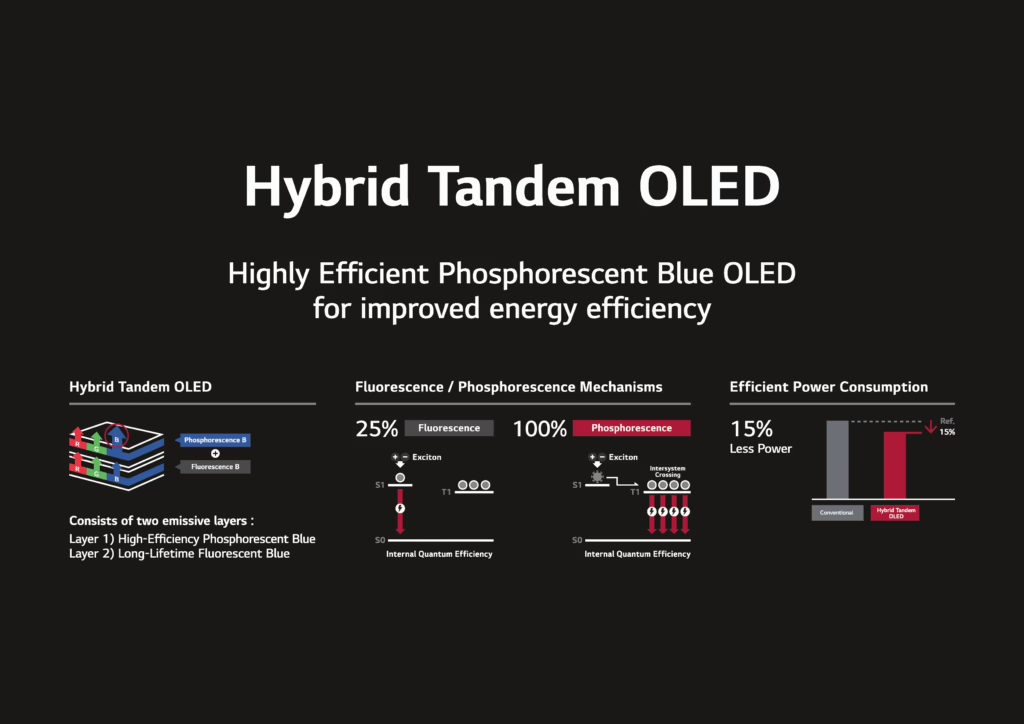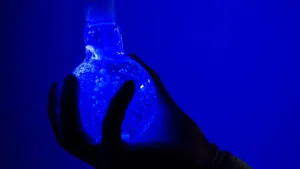LG Display has become the first company worldwide to successfully verify commercialization-level performance of blue phosphorescent OLED panels on a mass production line, marking a significant advancement in display technology. The breakthrough comes approximately eight months after LG Display partnered with Universal Display Corporation (UDC) to develop blue phosphorescence technology, considered the final piece in creating what the industry calls a “dream OLED” – a display that achieves phosphorescence for all three primary colors of light.
LG Display’s solution employs a hybrid two-stack Tandem OLED structure that combines blue fluorescence in the lower stack with blue phosphorescence in the upper stack. This approach consumes approximately 15% less power while maintaining stability comparable to existing OLED panels.

The development of blue OLEDs that exhibit both high stability and efficiency has presented a formidable challenge to the display industry. Numerous degradation mechanisms are at play within the complex structure of OLED devices, and achieving the precise balance of various device parameters necessary for optimal blue light emission has proven to be particularly difficult. Consequently, blue OLEDs have historically demonstrated shorter operational lifespans when compared to their red and green counterparts. Research has indicated that the lifespan of blue OLEDs can be significantly less than that of red or green emitters, potentially compromising the overall longevity of full-color OLED displays. This issue is often cited by consumers, with experiences of white hues degrading over time in OLED screens, a problem attributed to the faster degradation of the blue component.
The fundamental reason for the instability of blue OLEDs lies in the high photon energy associated with deep-blue light emission. This high energy makes the organic materials used in blue emitters susceptible to photochemical instability, leading to rapid degradation of the device over time. The suboptimal performance of blue OLEDs not only affects their stability but also has a direct impact on the overall energy efficiency of the display. Furthermore, blue OLEDs typically exhibit wider full-width-at-half-maximum (FWHM) values in their emission spectra compared to red and green emitters. This broader emission spectrum hinders the achievement of high color purity, which is a critical requirement for high-end electronic displays. Meeting the stringent CIE (Commission Internationale de l’Éclairage) color coordinates for deep blue, specifically (0.131, 0.046), has been a persistent challenge due to the scarcity of both pure-blue and deep-blue phosphors, along with compatible host materials.
The precise mechanisms that cause blue OLEDs to degrade are complex and have not been fully elucidated, which in turn limits the ability to implement effective strategies for improving their stability. However, research has identified chemical degradation occurring at the interface between the emission layer and the electron transport layer, particularly the loss of oxygen in molecules, as a significant factor contributing to the degradation of blue OLEDs. Another critical challenge lies in the limited availability of suitable host materials for blue emitters. These host materials need to possess sufficiently high triplet energies and wide bandgaps to enable efficient energy transfer to the blue emitter and prevent energy losses. The OLED display industry has often resorted to a compromise by utilizing red and green phosphorescent emitters, which offer high efficiency and stability, while relying on blue fluorescent emitters, which have lower efficiency, often in conjunction with upconversion techniques like triplet-triplet annihilation (TTA-UC). However, achieving high efficiencies with TTA-UC devices is technically demanding due to the involvement of a sensitizer that can introduce its own set of issues.
UDC’s PHOLEDs levrage the principle of phosphorescence to achieve substantially higher internal efficiencies compared to their fluorescent counterparts. Traditional fluorescent OLEDs are limited in their efficiency because they primarily utilize only singlet excitons, which constitute approximately 25% of the excitons generated within the device. The remaining 75% of triplet excitons typically decay non-radiatively, leading to energy loss and reduced overall efficiency. In contrast, PHOLEDs are designed to harness both singlet and triplet excitons for light emission, enabling them to potentially achieve an internal quantum efficiency (IQE) of nearly 100%. This capability can result in an efficiency that is up to four times greater than that of fluorescent OLEDs.
The process of phosphorescence involves a longer transition period for excited electrons to return to their ground state, specifically from an excited triplet state. This transition is facilitated by incorporating organometallic complexes containing heavy metal atoms, such as iridium or platinum, into the emissive layer. The presence of these heavy metal atoms enhances spin-orbit coupling within the molecule, which in turn accelerates intersystem crossing (ISC) from singlet to triplet excited states and promotes radiative decay (phosphorescence) from the triplet state to the ground state. Due to their inherent high efficiency and stability, phosphorescent emitters are commonly used for red and green OLEDs in commercially available displays.
PHOLED technology offers several key advantages, including significantly lower power consumption due to the higher efficiency in converting electrical energy into light. While achieving long lifespans for blue PHOLEDs has been a persistent challenge, the inherent efficiency of the technology holds the potential for longer operational lifetimes compared to fluorescent blue OLEDs. Furthermore, the increased efficiency of PHOLEDs can translate to brighter displays, enhancing the viewing experience, particularly in high ambient light conditions.
Soo-young Yoon, CTO and Executive Vice President of LG Display, called the development “an innovative milestone towards the next generation of OLED.”
The company plans to showcase a blue phosphorescent OLED panel featuring the two-stack Tandem technology at SID Display Week 2025 in San Jose, California, beginning May 11. LG Display has also filed patents for its hybrid blue phosphorescent OLED technology in both South Korea and the United States.

